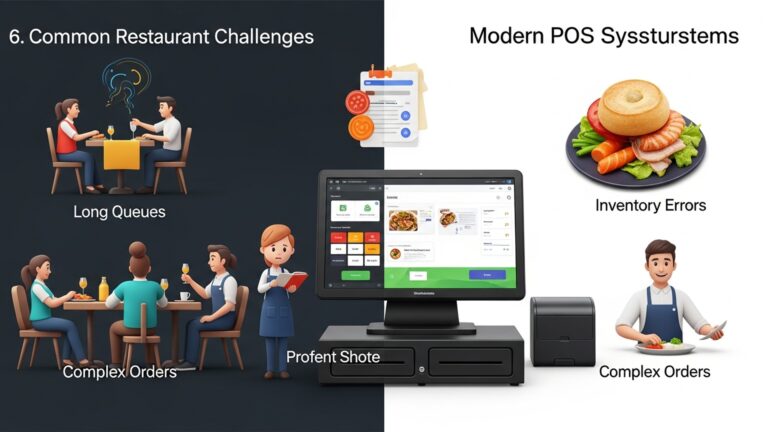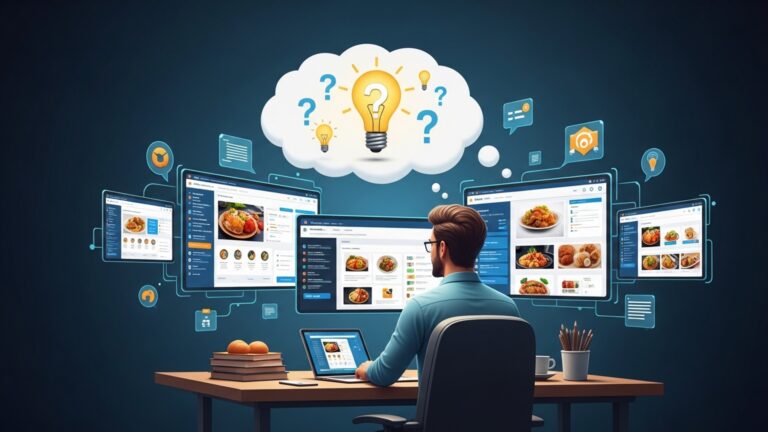Why 8 Restaurant Owners Are Upgrading Their POS Systems Now
The culinary landscape is evolving at an unprecedented pace, challenging restaurant owners with rising labor costs, intricate supply chains. the imperative for seamless digital experiences. Legacy point-of-sale systems, once adequate, now struggle to keep up, acting as operational bottlenecks rather than growth enablers. Forward-thinking restaurateurs are recognizing this shift, actively upgrading their infrastructure to advanced Restaurant POS software. These modern platforms integrate crucial functionalities like real-time inventory management, robust online ordering capabilities. actionable sales analytics, allowing owners to optimize staff schedules, minimize food waste. deliver personalized customer service. This strategic investment isn’t merely about processing transactions; it’s about harnessing data and automation to navigate current market complexities and secure a competitive edge in a demanding industry.
Addressing Outdated Technology and Legacy Systems
Many restaurant owners find themselves tethered to legacy Point of Sale (POS) systems that simply can’t keep pace with today’s dynamic hospitality landscape. These older systems, often server-based and requiring manual updates, frequently become bottlenecks rather than enablers. They are prone to slow transaction speeds, frequent crashes. a general lack of intuitive user interfaces that frustrate both staff and customers.
For instance, imagine a bustling Friday night service where an outdated system lags during peak order taking, leading to longer wait times and a dip in customer satisfaction. This scenario is all too common. Upgrading to modern Restaurant POS software is a critical move, as these new solutions are typically cloud-based, offering enhanced stability, automatic updates. robust performance. This shift from on-premise to cloud infrastructure eliminates the need for expensive hardware maintenance and dedicated IT staff, allowing restaurateurs to focus on what they do best: serving great food and creating memorable experiences.
Consider the story of “The Daily Grind,” a popular cafe that struggled with a 10-year-old POS system. Owner Maria knew the system was a bottleneck. “Our old system would freeze during our busiest hours,” she recounts. “Staff spent more time troubleshooting than serving. Moving to a cloud-based solution was like night and day. Orders are faster. we haven’t had a single system crash since.”
Elevating the Customer Experience
In an increasingly competitive market, customer experience is paramount. Modern Restaurant POS software plays a pivotal role in creating seamless and personalized interactions that foster loyalty. Older systems often lack the capabilities to integrate with essential customer-facing tools like online ordering platforms, loyalty programs. personalized marketing campaigns.
New POS systems empower restaurants to:
- Offer integrated online ordering, allowing customers to place orders directly from their phones or computers for pickup or delivery.
- Manage loyalty programs that reward repeat business with points, discounts, or exclusive offers.
- Capture customer data (with consent) to personalize future marketing efforts, such as sending birthday offers or recommending items based on past purchases.
- Facilitate contactless payments, including mobile wallets and QR code payments, enhancing convenience and hygiene.
According to a study by Deloitte, customer experience is a key differentiator, with 80% of customers stating that the experience a company provides is as vital as its products or services. Upgrading ensures that every touchpoint, from browsing the menu to paying the bill, is smooth and satisfying.
Streamlining Operational Efficiency
Beyond customer-facing improvements, modern Restaurant POS software is a powerhouse for backend operational efficiency. Legacy systems often require manual input for inventory, separate systems for staff scheduling. cumbersome processes for sales reporting. This fragmentation leads to inefficiencies, errors. wasted time.
New POS solutions integrate multiple facets of restaurant operations into a single, cohesive platform. Key areas of improvement include:
- Inventory Management
- Staff Management
- Order Accuracy and Speed
- Reporting and Analytics
Real-time tracking of ingredients, automated alerts for low stock. integration with suppliers to streamline ordering. This significantly reduces waste and ensures popular items are always available.
Features for time clock management, shift scheduling. performance tracking, reducing administrative burdens and optimizing labor costs.
Digital order taking, direct kitchen display system (KDS) integration. tablet-based ordering reduce errors and dramatically speed up service.
Comprehensive sales data, peak hour analysis. item performance reports help owners make informed decisions about menus, promotions. staffing.
For example, “Pizza Palace” reduced food waste by 15% within three months of implementing new Restaurant POS software with robust inventory tracking. Owner Mark commented, “Before, we were guessing. Now, we know exactly what we have, what we need. when to order. It’s saved us thousands.”
Leveraging Data for Informed Decision-Making
One of the most transformative aspects of modern Restaurant POS software is its ability to collect, examine. present valuable data. Old systems offered rudimentary sales reports, if any, making it difficult for owners to comprehend underlying trends or pinpoint areas for improvement. Today, data is king. a smart POS system is your most trusted advisor.
Advanced analytics capabilities allow restaurant owners to:
- Identify best-selling items and those that underperform, guiding menu optimization.
- Track sales patterns by day, week, or season, enabling more accurate forecasting and staffing.
- grasp labor costs in relation to sales, optimizing schedules to maximize profitability.
- Monitor ingredient usage and waste, leading to better cost control.
- review customer behavior, including average spend and loyalty program engagement, to refine marketing strategies.
This data-driven approach moves restaurant management from guesswork to strategic planning. As industry expert Chef Emily Rodriguez often emphasizes, “In today’s culinary world, your POS is not just a cash register; it’s a powerful business intelligence tool.”
Ensuring Robust Security and Compliance
Data security and regulatory compliance are non-negotiable in the digital age. Legacy POS systems often lack the built-in security features necessary to protect sensitive customer payment insights and comply with modern standards. This exposes businesses to significant risks, including data breaches, fines. reputational damage.
Upgrading to contemporary Restaurant POS software ensures adherence to crucial security protocols and industry standards:
- EMV Compliance
- PCI DSS Compliance
- Data Encryption
- Cloud Security
Support for chip card transactions, which are significantly more secure than traditional magnetic stripe cards, reducing fraud liability for businesses.
Adherence to the Payment Card Industry Data Security Standard, a set of security standards designed to ensure that all companies that process, store, or transmit credit card insights maintain a secure environment.
Protecting customer and business data both in transit and at rest, minimizing the risk of unauthorized access.
Leveraging the robust security infrastructure of major cloud providers, often superior to what individual restaurants can maintain on-premise.
The cost of a data breach can be astronomical, not just in fines but in lost customer trust. A secure POS system is an investment in the long-term viability and reputation of a restaurant.
Achieving Scalability and Flexibility
Growth is the goal for many restaurant owners, whether through expanding menus, adding new services, or opening additional locations. Legacy POS systems often present significant hurdles to scalability, requiring extensive hardware overhauls or complex software reconfigurations for every change. This rigidity stifles innovation and expansion.
Modern, cloud-based Restaurant POS software is inherently designed for scalability and flexibility:
- Multi-Location Management
- Integration Capabilities
- Hardware Flexibility
- Feature Expansion
Easily manage operations, menus. reporting across multiple restaurant sites from a single dashboard.
Seamlessly connect with third-party applications like accounting software, online reservation systems, delivery platforms. payroll services through APIs (Application Programming Interfaces). This creates a holistic ecosystem tailored to specific business needs.
Often compatible with a wide range of devices, from traditional terminals to tablets and smartphones, allowing restaurants to adapt their setup as needed without proprietary hardware lock-ins.
New features and updates are rolled out automatically by the software provider, ensuring the system evolves with industry trends without requiring manual installations or costly upgrades.
This adaptability is crucial for businesses aiming for sustainable growth. For instance, “Global Bites,” a chain of ethnic restaurants, expanded from three to eight locations in two years, largely crediting their scalable POS system for the smooth transition. “We could roll out new menus and manage inventory for all locations from one central point,” says CEO David Chen. “It made expansion incredibly efficient.”
Realizing Long-Term Cost Savings
While the initial investment in new Restaurant POS software might seem significant, many restaurant owners recognize the substantial long-term cost savings it offers. Legacy systems often come with hidden costs: expensive maintenance contracts, frequent repair needs, manual workaround labor. the financial impact of errors and inefficiencies.
Modern POS solutions contribute to cost savings in several key ways:
- Reduced Hardware Costs
- Lower Labor Costs
- Minimized Food Waste
- Improved Error Rates
- Energy Efficiency
Cloud-based systems often require less specialized hardware. many run on affordable tablets. Eliminating on-premise servers also reduces IT infrastructure costs.
Automation in areas like inventory management, scheduling. order processing reduces the need for manual tasks, allowing staff to focus on higher-value activities. Faster service can also lead to higher table turnover.
Accurate inventory tracking and forecasting directly translate to less spoiled food and optimized ordering, significantly impacting food costs.
Digital order taking and kitchen display systems drastically reduce order errors, saving on comps and re-dos.
Modern, often tablet-based systems consume less power than bulky legacy terminals and servers.
According to industry analysis by Restaurant Business Online, optimizing kitchen and service operations through technology can shave several percentage points off operational costs, directly boosting profit margins. The ROI (Return on Investment) for a well-chosen POS system can be surprisingly quick.
Adapting to New Market Trends and Consumer Expectations
The restaurant industry is constantly evolving, with new trends emerging that reshape consumer expectations. From the rise of food delivery services to the demand for contactless interactions, restaurants must adapt quickly to stay relevant. Older POS systems simply cannot support these modern necessities, leaving businesses at a competitive disadvantage.
Upgrading to contemporary Restaurant POS software ensures that restaurants are equipped to embrace and even lead these trends:
- Integrated Delivery Services
- Contactless Menus and Ordering
- Online Reservations and Waitlist Management
- Pop-up and Event Flexibility
Seamlessly manage orders from popular third-party delivery apps (e. g. , DoorDash, Uber Eats) directly through the POS, consolidating order streams and preventing missed orders.
Utilize QR codes for digital menus, allowing customers to view menus and sometimes even order directly from their smartphones, enhancing safety and convenience.
Integrate with reservation systems to streamline seating and reduce physical queues.
Cloud-based systems can be easily deployed in temporary locations or for catering events using mobile devices, expanding revenue opportunities.
The COVID-19 pandemic significantly accelerated the adoption of many of these technologies. Restaurants that quickly adapted with robust POS systems were better positioned to survive and even thrive. As restaurant technology consultant Sarah Lee notes, “A modern POS isn’t just about efficiency; it’s about resilience and staying relevant in a fast-changing world.”
Conclusion
The decision by eight restaurant owners to upgrade their POS systems isn’t just a fleeting trend; it’s a strategic imperative driven by a pressing need for operational efficiency, insightful data. an enhanced customer journey. Don’t underestimate the transformative power a modern system holds for your daily operations, from precise inventory tracking to streamlined staff management. My personal tip: focus on systems that offer robust, real-time analytics. It’s truly eye-opening to see exactly where your profits are being made or lost instantly, rather than waiting for end-of-month reports. In today’s fast-paced environment, where diners expect seamless experiences and quick service, clinging to an outdated system is akin to driving with a flat tire. Recent developments, like the surge in online ordering and contactless payments, demand a flexible, integrated solution that can adapt and grow with your business. By choosing to upgrade now, you’re not merely solving present problems; you’re actively future-proofing your business. Take that decisive step; your restaurant’s sustained profitability and customer loyalty depend on it.
More Articles
How to Choose the Best POS System 5 Key Strategies for Restaurant Success
Learn 5 Key Steps to Choosing the Best Restaurant POS System
Discover 7 Essential Restaurant POS Features to Boost Your Business Efficiency
7 Essential Ways Restaurant POS Software Boosts Your Business Profitability
Unlock Efficiency 6 Common Restaurant Problems Solved by POS Systems
FAQs
Why are so many restaurant owners ditching their old POS systems these days?
Many are finding their current systems just can’t keep up with today’s fast-paced restaurant scene. They’re looking for something more efficient, reliable. capable of handling everything from online orders to detailed inventory management.
How does a new POS actually help a busy restaurant run smoother?
It’s a game-changer for operations. Think faster order taking, smoother kitchen communication, quicker table turns. less manual work for staff. This all means happier customers and a less stressed team, boosting overall efficiency.
Is this upgrade mostly about making customers happier?
Absolutely, that’s a huge part of it! Modern POS systems offer things like integrated online ordering, loyalty programs, easy payment options. even personalized promotions, all of which significantly boost the customer experience and encourage repeat business.
What kind of insights can a new POS system give me about my business?
Oh, tons! You can track sales trends, identify your most popular dishes, see peak hours, monitor staff performance. even get a clearer picture of your inventory usage. This data is invaluable for making smart business decisions and optimizing your menu.
Won’t upgrading be super expensive? How do owners justify the cost?
While there’s an initial investment, many owners see a quick return. The savings come from reduced food waste (better inventory), improved staff efficiency, fewer errors. increased sales from better customer engagement. It’s often about long-term gain and staying competitive.
Are there any security benefits to getting a new system?
Definitely. Older systems often lack the latest security protocols, making them vulnerable. Newer POS systems come with enhanced data encryption, PCI compliance features. more secure payment processing, which protects both the business and its customers from potential threats.
What if my restaurant’s needs change down the line? Can these new systems adapt?
That’s one of their biggest strengths! Modern POS systems are designed to be flexible and scalable. They can easily integrate with new third-party apps (like delivery services or accounting software) and often update automatically, ensuring you’re always using the latest tech without a complete overhaul.




